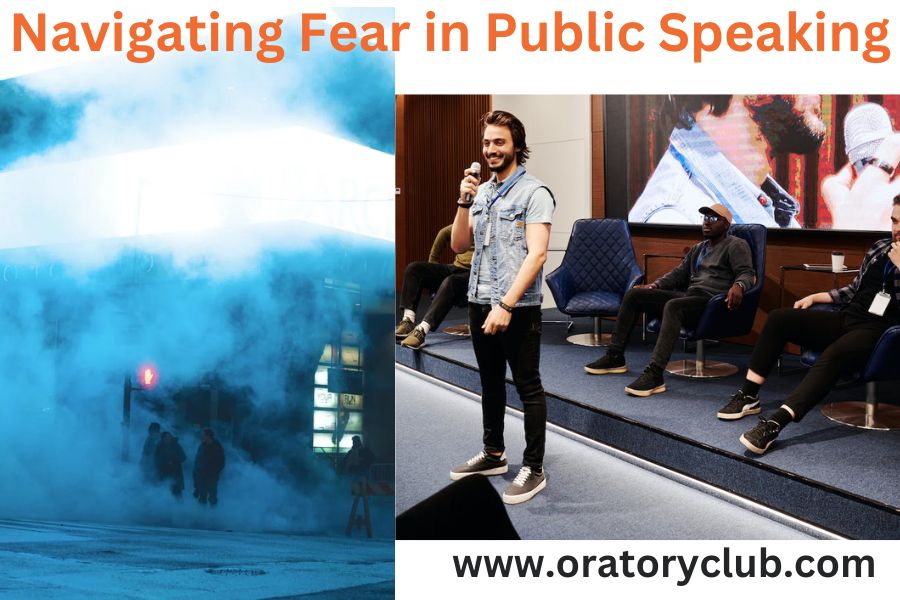Navigating Fear in Public Speaking: A Journey from Fog to Clarity
Public speaking, often touted as one of the most common fears, is much like encountering fog on a path. Initially, the fear can feel overwhelming, clouding your thoughts and confidence. However, as you progress and gain experience, the fog of fear begins to dissipate, allowing you to see clearly and navigate the world of public speaking with confidence. In this blog post, we’ll delve into this analogy, exploring how fear in public speaking parallels the experience of fog and the transformative journey that lies ahead. So, Let’s start Navigating Fear in Public Speaking.
1. Fear as the Initial Fog
Picture yourself standing at the edge of a path shrouded in thick fog. Similarly, when you confront the prospect of public speaking, fear can cloud your mind, casting doubts on your abilities. This fear is often rooted in the fear of judgment, forgetting your lines, or stumbling over words in front of an audience. Just as the fog limits your visibility, fear can restrict your confidence and hinder effective communication.

2. Starting the Journey
Embarking on your public speaking journey is akin to taking those first steps into the fog. It’s a moment of uncertainty and anticipation. The fear that accompanies public speaking often stems from the unknown, the “what ifs” that play in your mind. Accepting that fear is a natural response and acknowledging its presence is the initial step towards dispelling it.
3. Gaining Experience as a Beacon
As you gather experiences on your public speaking journey, each speech becomes a beacon of light that pierces through the fog of fear. With each successful presentation, you begin to feel a gradual shift. The more you expose yourself to speaking situations, the more you realize that the fear begins to lose its grip.
4. Preparation as a Clearing Agent
Imagine the sun breaking through the fog, gradually illuminating the landscape. In the realm of public speaking, preparation serves as the sunlight that dispels the fog of fear. When you invest time in researching your topic, structuring your speech, and rehearsing your delivery, you equip yourself with the tools needed to face your fears head-on. The more prepared you are, the more confident and clear-headed you become.
5. Facing Challenges Head-On
Navigating through fog requires determination and adaptability. Similarly, facing the challenges of public speaking head-on can help you build resilience. The more you engage with your fear, the more you learn to manage it. Whether it’s conquering stage fright, dealing with unexpected technical glitches, or handling questions from the audience, confronting these challenges gradually erodes the fog of fear. Just as the landscape becomes clearer as you forge ahead, your confidence begins to take root.
6. Learning from Mistakes
Think of the fog of fear as a canvas where mistakes are inevitable brushstrokes. In the realm of public speaking, mistakes are a natural part of the journey. Just as the fog obscures your view, fear can make you magnify every mistake, leading to self-doubt. However, mistakes aren’t setbacks but rather stepping stones to improvement. Embrace them as opportunities to learn and grow. Analyze what went wrong, identify areas for improvement, and adjust your approach accordingly. With each misstep, the fog of fear recedes a little further, revealing a path of progress.
7. Feedback as a Guiding Light
Imagine a lantern piercing through the fog, illuminating your way. Feedback serves a similar purpose on your journey to conquer fear in public speaking. Seek out constructive feedback from mentors, peers, or even self-assessment. This feedback acts as a guiding light, helping you make informed decisions about your content, delivery, and overall presentation. Constructive criticism helps you adjust your approach, refine your techniques, and build confidence in your abilities. As you integrate feedback, you’ll find the fog of fear gradually giving way to clarity.
8. Growing Confidence
With each successful speech, your confidence grows. This growth can be likened to the increasing visibility as the fog lifts. As you practice and refine your skills, you’ll start to internalize your capabilities. Remember that confidence isn’t about eliminating fear entirely but about managing it. The more you push through the fog of fear, the more you realize that your fears were often more intimidating than the actual experience. Celebrate each accomplishment, whether big or small, as a milestone on your journey toward clarity.
9. Adapting to Changing Conditions
Just as fog is known to shift and change, the challenges in public speaking can vary from one speaking opportunity to another. Adaptability is a valuable skill that helps you navigate through uncertainty. As you encounter different audiences, venues, and topics, you’ll learn to adjust your approach accordingly. Adapting to changing conditions is crucial for successful public speaking, and the more you embrace this skill, the more you gain control over the fog of fear.
10. Achieving Clarity and Mastery
Imagine standing on a hill, watching the fog gradually disperse and reveal a clear landscape. Similarly, as you continue your journey in public speaking, the fog of fear starts to give way to clarity. You begin to see your audience, engage with them, and deliver your message with increasing confidence. Your growth as a speaker is marked by your ability to manage fear, harnessing its energy to drive your performance. This process isn’t about eliminating all fear; rather, it’s about mastering it. Embrace your fear, learn from it, and let it guide you towards becoming a more skilled and impactful public speaker.
In Conclusion
The analogy of fear in public speaking being akin to fog is a profound one. Both scenarios involve stepping into the unknown, facing uncertainties, and relying on gradual progress to see clearly. Just as fog dissipates with time and experience, fear in public speaking lessens as you gain competence, confidence, and an understanding of your audience. Embrace the journey, acknowledge your fears, and remember that with persistence, the fog of fear will give way to the clarity of confident communication.


